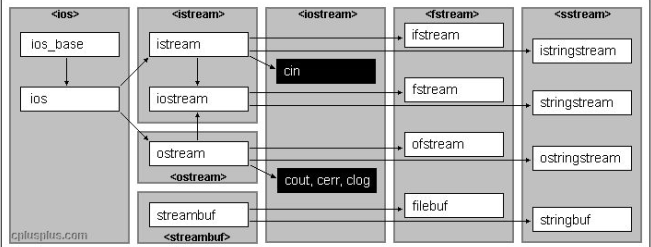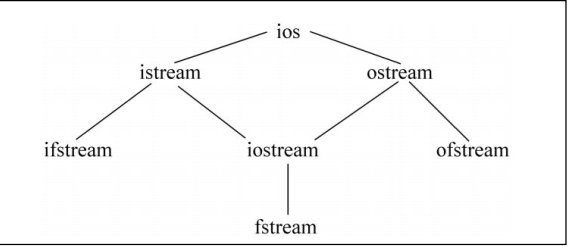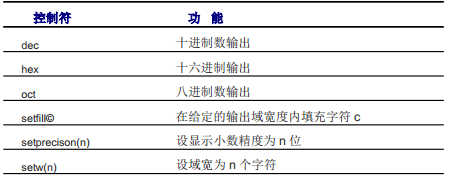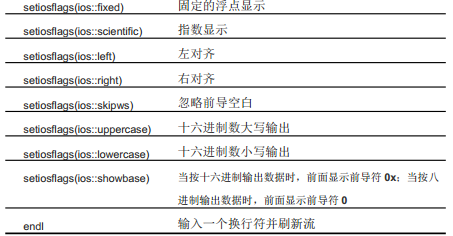1 io类图关系

1.1 简化形式

1.1.2补充
iostream:
istream:从流中读取
ostream:写入到流
iosteram:读写流
fstream:
ifstream:从文件读
ofstream:写入文件
fstream:读写文件
2 流综述
2.1什么情况会导致刷缓冲
(1)程序正常结束,作为main函数结束的一部分将清空所有的缓冲区
(2)缓冲区满会刷缓冲
(3)endl flush刷缓冲
(4)在每次输出操作执行完后用unitbuf操作符设置流内部状态从而清空缓冲区
2.2 标准输出
输出流对象:cout,cerr,clog
2.2.1格式化输出iomanip
(1)相关控制符和功能如下图所示


(2)用格式控制符控制输出(记得包括头文件iomanip哦 下面也是)
1 int main() 2 { 3 4 int n = 20; 5 cout << "设置进制:" << endl; 6 cout << "十进制" << n << endl; 7 cout << "十六进制" << hex << n << endl; 8 cout << "八进制" << oct << n << endl; 9 cout << "十进制" << dec << n << endl; 10 cin.get(); 11 return 1; 12 }
(3)设置域宽::::setw(n)n小于实际宽度按照实际宽度输出
1 int main() 2 { 3 int m = 1234; 4 cout << "设置域宽" << endl; 5 cout << setw(3) << m << endl;//1234 6 cout << setw(5) << m << endl;// 1234 7 cout << setw(10) << m << endl;//1234 8 cin.get(); 9 10 return 1; 11 }
(4)设置填充字符setfil。。。。。需要和setw一起使用
1 int main6() 2 { 3 int x = 1234; 4 cout << "设置填充字符" << endl; 5 cout << setfill('*')<<setw(5)<<x<< endl;//*1234 6 cout << setw(10)<<x<< endl;// ******1234 7 8 cin.get(); 9 return 1; 10 }
(5)设置对齐方式setiosflags(ios::left/right)
1 int main7() 2 { 3 int y = 1234; 4 cout << "设置对齐方式" << endl; 5 cout << setfill(' '); 6 cout << setiosflags(ios::left) << setw(10) << y << endl; 7 cout << setiosflags(ios::right) << setw(10) << y << endl; 8 9 cin.get(); 10 return 1; 11 12 }
(6)显示小数点和正负数符号
1 int main8() 2 { 3 double d1 = 10 / 5, d2 = 22.0 / 7; 4 cout << "显示小数点尾和数符" << endl; 5 cout << d1 << endl;//2 6 //2.00000 7 cout << setiosflags(ios::showpoint) << d1 << endl; 8 //+3.14286强制显示符号 9 cout << setiosflags(ios::showpos) << d2 << endl; 10 //+3.14286 11 cout << d2 << endl; 12 cin.get(); 13 return 1; 14 15 }
(7)设置进度
1 int main10() 2 { 3 double dd = 123.4567; 4 //1.2e+002 5 cout << setprecision(2) << dd << endl; 6 //123 7 cout << setprecision(3) << dd << endl; 8 //123.5 9 cout << setprecision(4) << dd << endl; 10 //123.46这里会四舍五入 11 cout << setprecision(5) << dd << endl; 12 cin.get(); 13 return 1; 14 15 }
3 标准输入cin
3.1 成员函数get
char get() 输入一个字符并返回(回车 tab等)
istream& get(char &)//实现链式编程
1 int main() 2 { 3 char ch; 4 while(cin.get(ch)) 5 { 6 cout.put(ch); 7 } 8 return 1; 9 }
istream& get(char*,int,char)//从输入流读取N-1字符,赋给字符数组
情况1:
1 int main() 2 { 3 char buf[1024]; 4 5 cin.get(buf, 1024, '/'); 6 //cin.ignore(1); 7 cout << buf << endl; 8 cin.get(buf, 1024, '/'); 9 10 cout << buf << endl; 11 system("pause"); 12 }

备注:这里没有ignore 按照字符/截断了
情况2:丢失了c
1 int main() 2 { 3 char buf[1024]; 4 5 cin.get(buf, 1024, '/');//输入i love china/ i love tianchao/ 6 cin.ignore(100,'c'); 7 cout << buf << endl; 8 cin.get(buf, 1024, '/'); 9 10 cout << buf << endl; 11 system("pause"); 12 }

情况三:退回到c
1 int main() 2 { 3 char buf[1024]; 4 5 cin.get(buf, 1024, '/'); 6 cin.ignore(100,'c');//忽略到c字符位置 保存后面的值 7 cin.putback('c'); 8 cout << buf << endl; 9 cin.get(buf, 1024, '/'); 10 11 cout << buf << endl; 12 system("pause"); 13 }

peek
1 int main() 2 { 3 char buf[1024]; 4 5 cin.get(buf, 1024, '/'); 6 cin.ignore(100,'c');//忽略到c字符位置 保存后面的值 7 cin.putback('c');//退回c 8 9 char peek = cin.peek(); 10 cout << "peek"<<peek << endl; 11 12 cout << buf << endl; 13 cin.get(buf, 1024, '/'); 14 15 cout << buf << endl; 16 system("pause"); 17 }

参数:字符数组 字符个数终止字符
注意:会清空char*指向的内容 如果没有读到n-1个字符或者终止符则会阻塞
3.2 getline
istream& getline(char*,int,char)
与get不同的是在读取n-1字符之前遇到终止字符会提前结束.两者最大不同是get当遇到定界符停止当时bu'hu
cin.getline(buf,1024,'g');